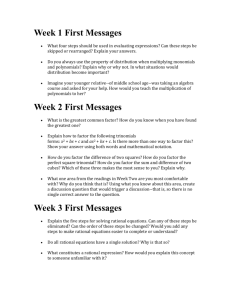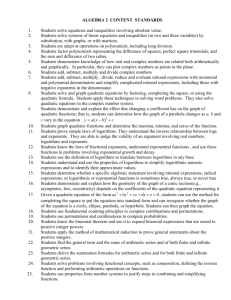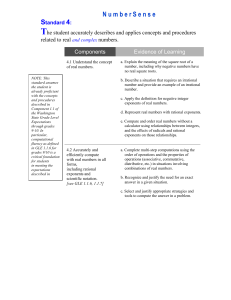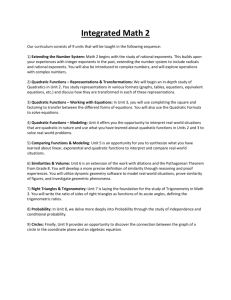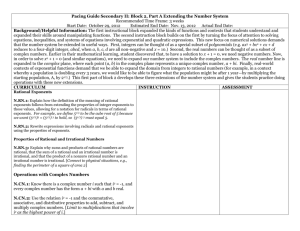Pacing Guide: Secondary Math II, Instructional Block 2, Part A
advertisement
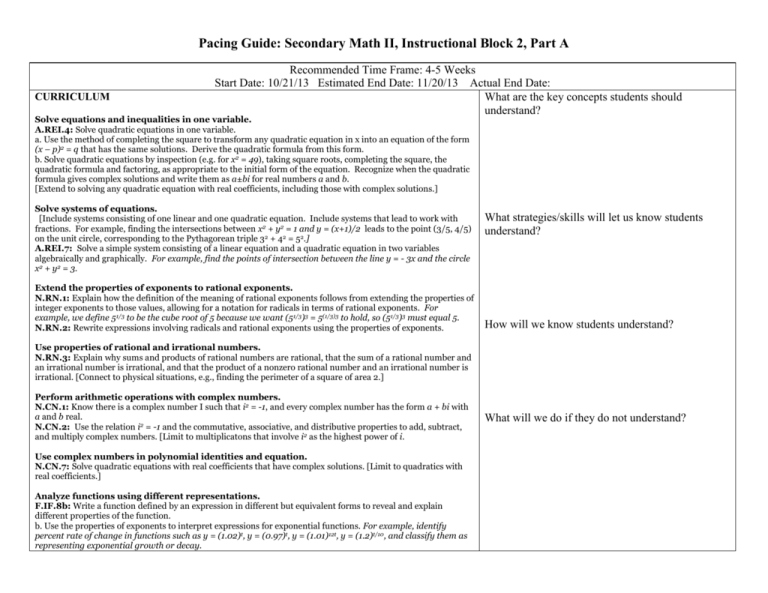
Pacing Guide: Secondary Math II, Instructional Block 2, Part A CURRICULUM Recommended Time Frame: 4-5 Weeks Start Date: 10/21/13 Estimated End Date: 11/20/13 Actual End Date: What are the key concepts students should understand? Solve equations and inequalities in one variable. A.REI.4: Solve quadratic equations in one variable. a. Use the method of completing the square to transform any quadratic equation in x into an equation of the form (x – p)2 = q that has the same solutions. Derive the quadratic formula from this form. b. Solve quadratic equations by inspection (e.g. for x2 = 49), taking square roots, completing the square, the quadratic formula and factoring, as appropriate to the initial form of the equation. Recognize when the quadratic formula gives complex solutions and write them as a±bi for real numbers a and b. [Extend to solving any quadratic equation with real coefficients, including those with complex solutions.] Solve systems of equations. [Include systems consisting of one linear and one quadratic equation. Include systems that lead to work with fractions. For example, finding the intersections between x2 + y2 = 1 and y = (x+1)/2 leads to the point (3/5, 4/5) on the unit circle, corresponding to the Pythagorean triple 32 + 42 = 52.] A.REI.7: Solve a simple system consisting of a linear equation and a quadratic equation in two variables algebraically and graphically. For example, find the points of intersection between the line y = - 3x and the circle x2 + y2 = 3. Extend the properties of exponents to rational exponents. N.RN.1: Explain how the definition of the meaning of rational exponents follows from extending the properties of integer exponents to those values, allowing for a notation for radicals in terms of rational exponents. For example, we define 51/3 to be the cube root of 5 because we want (51/3)3 = 5(1/3)3 to hold, so (51/3)3 must equal 5. N.RN.2: Rewrite expressions involving radicals and rational exponents using the properties of exponents. What strategies/skills will let us know students understand? How will we know students understand? Use properties of rational and irrational numbers. N.RN.3: Explain why sums and products of rational numbers are rational, that the sum of a rational number and an irrational number is irrational, and that the product of a nonzero rational number and an irrational number is irrational. [Connect to physical situations, e.g., finding the perimeter of a square of area 2.] Perform arithmetic operations with complex numbers. N.CN.1: Know there is a complex number I such that i2 = -1, and every complex number has the form a + bi with a and b real. N.CN.2: Use the relation i2 = -1 and the commutative, associative, and distributive properties to add, subtract, and multiply complex numbers. [Limit to multiplicatons that involve i2 as the highest power of i. Use complex numbers in polynomial identities and equation. N.CN.7: Solve quadratic equations with real coefficients that have complex solutions. [Limit to quadratics with real coefficients.] Analyze functions using different representations. F.IF.8b: Write a function defined by an expression in different but equivalent forms to reveal and explain different properties of the function. b. Use the properties of exponents to interpret expressions for exponential functions. For example, identify percent rate of change in functions such as y = (1.02)t, y = (0.97)t, y = (1.01)12t, y = (1.2)t/10, and classify them as representing exponential growth or decay. What will we do if they do not understand? Write expressions in equivalent forms to solve problems. A.SSE.3c: Choose and produce an equivalent form of an expression to reveal and explain properties of the quantity represented by the expression.* c. Use the properties of exponents to transform expressions for exponential functions. For example the expression 1.15t can be rewritten as (1.151/12)12t = 1.01212t to reveal the approximate equivalent monthly interest rate if the annual rate is 15%. Create equations that describe numbers or relationships. A.CED.4: Rearrange formulas to highlight a quantity of interest, using the same reasoning as in solving equations. For example, rearrange Ohm’s law V = IR to highlight resistance R. [Extend to formulas involving squared variables.] Perform arithmetic operations on polynomials. A.APR.1: Understand that polynomials form a system analogous to the integers, namely, they are closed under the operations of addition, subtraction, and multiplication; add, subtract, and multiply polynomials. Related standards: A.SSE.1 INSTRUCTION mVp Secondary II, Module 3: Quadratic Equations Tasks and Ready, Set, Go For additional resources, go to http://www.slcschools.org/departments/curriculum/math/SecondaryIISaltLakeCitySchoolDistrict.php ASSESSMENT Before Instruction: Interim Assessment 2 (Pre-test) During Instruction (also informs Tier 2): Warm-ups, Quizzes After Instruction: Unit Test , Performance Assessment CURRICULUM KEY Bolded items are expected to be mastered by the end of the Unit. Italicized items are smaller pieces of the standard expected to be mastered by the end of the Unit. Strike through items are pieces of the standard not addressed in the Unit. All standards addressed in Unit instruction are listed in Curriculum.

